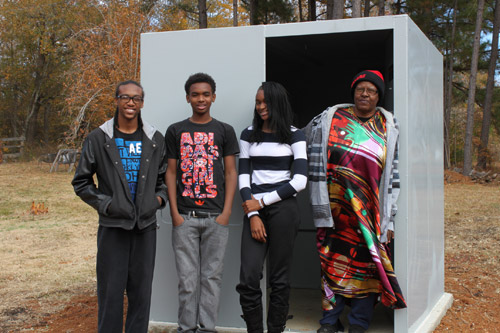SUSAN Kim
United Methodist Committee on Relief
While the memory of devastating 2011 storms In north Alabama will never fully fade, many residents there celebrated the Christmas season feeling safer than they ever have.
With support from the United Methodist Committee on Relief (UMCOR), residents now have 91 residential storm shelters.
It’s one of many places across the country where UMCOR has helped people move from early response, to long-term recovery, to disaster risk reduction.
Considering that 254 people lost their lives in the 2011 storms, these storm shelters represent not only safety but hope for a future less filled with tragedy.
Ready for the next disaster
Hundreds of miles away In Crisfield, Md., residents are also becoming more disaster-resilient. After Hurricane Sandy swept nearly a foot of water into dozens of homes there, UMCOR helped support a disaster recovery that drew hundreds of volunteer teams from across the country.
Now, Crisfield has adopted a disaster risk reduction program in which homes are better secured against future storms, said Ben Botti, who is helping to coordinate volunteer projects in the town.
“We’ve got 10-12 volunteer teams lined up for 2016,” said Botti. They will be replacing roofs and siding, as well as making other improvements that will help homes sustain less damage in the future.
Until the last survivor is home
In the wake of a disaster, even after no new needs are discovered, UMCOR stays until the last disaster survivor goes home, pointed out Mike Moore, flood recovery director for the Rocky Mountain Conference.
In 2013, severe floods damaged hundreds of homes across Colorado. Recovery is nearly complete, Moore said.
“We’re phasing out our case management portion of this and will continue on with volunteer coordination until all the homes are repaired,” said Moore. “We will still need teams for 2016.”
Disaster recovery does end
Long-term disaster recovery can go on for months and years — but it does end, pointed out Amelia Fletcher, disaster response coordinator in the Alabama-West Florida Conference.
Now completing flood recovery in the Pensacola area, Fletcher and her team will refer non-disaster-related needs to local social service agencies. “When flood recovery ends, you often are left with homes that have deferred maintenance, which has to come under a different banner,” she explained. “We have to keep our focus on disaster recovery.”
Even though disaster responders use words such as “close-out” and “transition,” in fact recovery always involves making people more able to cope with the next disaster, and so the focus on forward-looking.
“Here,” said Fletcher, “we know there will be a next disaster. But we see our experience, and the fact that we are able to rebuild even better, as a huge asset.”
Your gift to UMCOR U.S. Disaster Response, Advance #901670, helps communities recover from disasters — and prepare for the next disaster.
Last Updated on November 10, 2023

